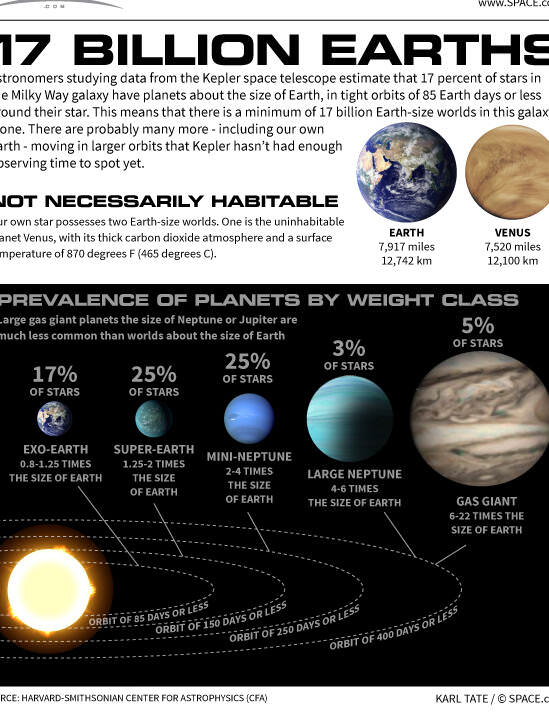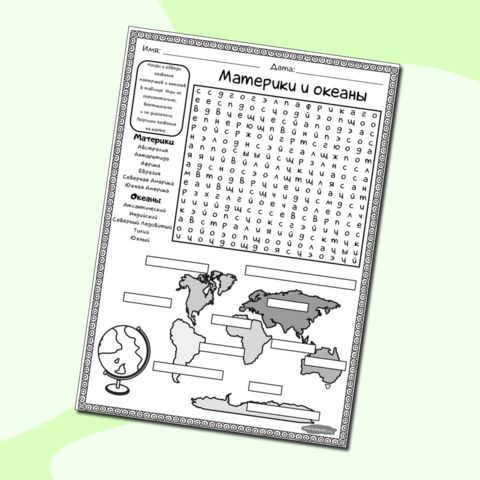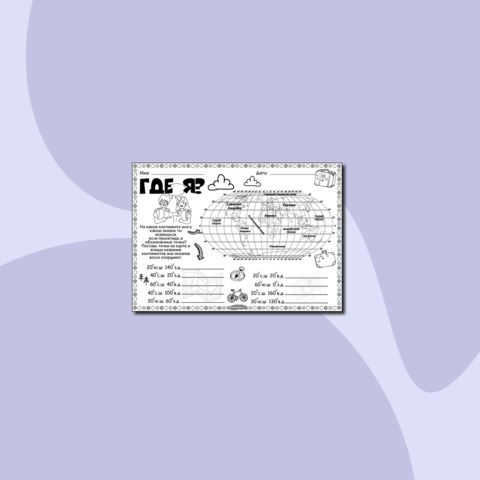7. When was the term “dwarf planets” first introduced?
8. How many dwarf planets are currently known in our solar system?
9. Can you name one of the dwarf planets?
10. In which year was Pluto officially discovered?
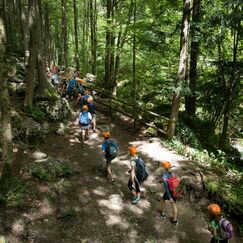
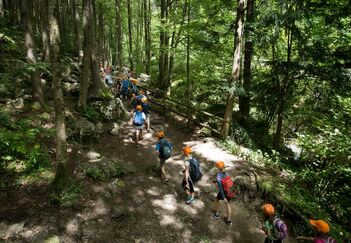


Professional development course
Using tourist techniques to teach geography to children with disabilities
We can apply a discount from your educational institution to this discount (it depends on the number of your colleagues who have taken Infoworks courses)
Currently, 58,742 educational institutions can access additional cumulative discounts ranging from 2% to 25%. To find out which discount applies to all employees of your educational institution, please log in to your personal Infoworks account.
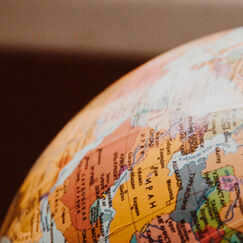
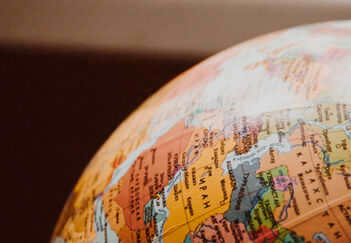
Enrich your professional skills
Innovative approaches to teaching geography in accordance with the FSES requirements
We can apply a special discount to this offer specifically for your educational institution (the amount of the discount will depend on the number of your colleagues who have completed Infoworks courses)
Currently, 58,742 educational institutions are benefiting from additional discounts (ranging from 2% to 25%). To find out the discount available for all employees of your educational institution, please log in to your personal Infoworks account.


Course for professional growth
Specifics of preparing for the geography section of the Unified State Exam in the context of implementing the Federal State Educational Standard
We can offer your educational institution an additional discount on top of the existing discount, depending on how many of your colleagues have already taken Infoworks courses.
Currently, we are offering additional cumulative discounts (ranging from 2% to 25%) to 58,742 educational institutions. To find out the discount available for all employees of your educational institution, please log in to your personal Infoworks account.


Revolutionizing your business and fostering innovative skills: a guide to increasing your pace
Resources and tools for instructors and educators
Over 10,000 educational resources for both classroom and remote learning
Innovations in the upcoming academic year 2023
Open meeting for educators and administrators
Discover resources for any lesson by selecting your subject (category), grade level, textbook, and topic:
There are 6,330,787 materials available in the database
The resources are compatible with the UMK curriculum
Additional resources
- Textbook: “Geography (published by “DROFA”)”, authored by Dronov V.P., Barinova I.I., and others / Edited by Dronov V.P.
- Chapter: § 7. Phases and approaches to studying a geographic area.
- Textbook: “Geography. Geology”, authored by Dronov V.P., Savelieva L.E.
- Chapter: § 7. Earth – a component of the Solar System
- Textbook: “Technology. Home Economics (published by VENTANA-GRAF)”, authored by Sinitsa N.V., Simonenko V.D.
- Subject: Culinary Arts
You may find these courses intriguing:
- Retraining course for professionals: “Marketing: Exploring the Theory and Methodology of Training in an Educational Setting”
- Retraining course for professionals: “Clinical Psychology: Implementing Rehabilitation Work in the Social Field”
- Professional development course: “Economics and Law: Understanding Taxes and Taxation”
- Retraining course for professionals: “Clinical Psychology: Unveiling the Theory and Methodology of Teaching in an Educational Setting”
- Professional development course: “Teaching Constitutional Law with a Focus on Implementing FSES”
- Retraining course for professionals: “Marketing Organization in the Tourism Industry”
- Retraining course “Corporate culture as a factor of modern organization’s efficiency”
- Development course “Financial Instruments”
- Retraining Course “Process of Insurance (Reinsurance) Organization”
- Retraining Course “Sales Implementation and Coordination”
- Retraining course “Organization of marketing activities”
- 05.06.2020 3234
- DOCX 14.8 kbytes
- 174 downloads
- Rating: 5 out of 5
- Rate the material:
If you think that the content infringes copyright or should be taken down from the website for any other reason, you can file a complaint regarding the material. Remove material
Author of the content
- Duration on the website: 5 years and 2 months
- Subscribers: 3
- Total views: 939423
- Total content: 246
Online courses
for educators
26 minutes
24 minutes
26 minutes
Gift Vouchers
The responsibility for resolving any disputes regarding the materials themselves and their content lies with the users who have uploaded the material on the website. However, the site administration is willing to provide all possible assistance in resolving any issues related to the functioning and content of the website. If you come across any illegally used materials on this website, please notify the site administration through the provided feedback form.
All materials published on the website are either created by the website authors or uploaded by the website users, and are presented on the website for informational purposes only. The copyrights of these materials belong to their respective legal authors. Partial or full reproduction of the website materials without the written permission of the site administration is strictly prohibited! The opinions expressed by the administration may not necessarily coincide with those of the authors.

During this lesson, we will explore the distinctions between the giant planets and the planets of the Earth group. We will acquaint ourselves with the peculiarities of the rotational movement exhibited by the giant planets. Additionally, we will examine certain aspects of the structure of the giant planets. Lastly, we will delve into the subject of planetary rings.

Currently, the video lesson is not available for viewing or sharing with students
In order to access this and other video lessons in the package, you must add it to your personal account.
Unlock amazing possibilities



Giant Planets Lesson Outline
Today, we will delve into the fascinating realms of the remaining four colossal planets: Jupiter, Saturn, Uranus, and Neptune.
Let’s commence our exploration with Jupiter, which holds the fifth position in our Solar System and reigns as the largest planet. Interestingly, Jupiter can be easily observed from Earth’s surface with the unaided eye, ranking second in brightness only to Venus. This celestial giant has captivated human attention since ancient times, and its name pays tribute to the formidable Roman deity of thunder.
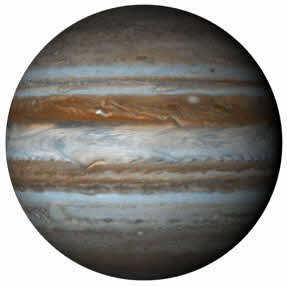
Jupiter’s mass is 2.47 times greater than the combined mass of all the other planets. Its equatorial radius is 11.2 times that of Earth. The planet is primarily composed of hydrogen and helium, similar to other planets in its group. Jupiter shares similarities with stars in terms of average density and the predominance of hydrogen and helium in its atmosphere.
Jupiter completes an orbit around the Sun in approximately 12 Earth years, while its rotation around its axis is incredibly fast, taking only about 10 Earth hours.
What we see on Jupiter are clouds floating in its atmosphere. These clouds are organized into bands parallel to the equator due to the planet’s rapid rotation and strong winds.
In December 1995, the Galileo probe made its way into the atmosphere of Jupiter. During its mission, the probe gathered crucial information about the composition of Jupiter’s atmosphere and the structure of its cloud layer. The majority of Jupiter’s atmosphere is composed of hydrogen and helium, with the remaining elements making up only 1% of its mass.
Similar to our own planet, Jupiter experiences the formation of cyclones and anticyclones, which can endure in its atmosphere for several centuries. One of the most well-known formations is the Great Red Spot, which has been observed for over 350 years. This massive hurricane is significantly larger than Earth in size.
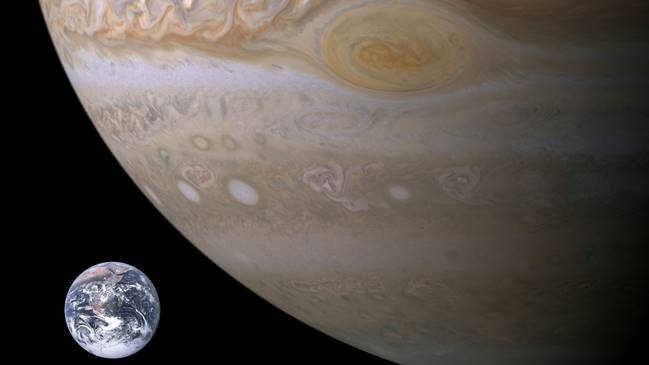
Based on the information gathered by the Galileo probe, the upper layers of Jupiter’s clouds have a temperature of -145 ℃ at a pressure of one atmosphere. However, as you go deeper, the pressure increases to 22 atmospheres at a depth of 146 kilometers, causing the temperature to rise to 153 ℃. At depths ranging from 7,000 to 25,000 kilometers, the hydrogen in Jupiter undergoes a gradual transition from a gaseous state to a liquid state. In the vicinity of the planet’s core, the pressure and temperature become so extreme that the hydrogen is compressed into a highly dense form known as liquid metallic hydrogen. In this state, the protons and electrons exist separately, resulting in a substance that exhibits high conductivity. Consequently, Jupiter possesses a magnetic field that is 12 times stronger than that of Earth.
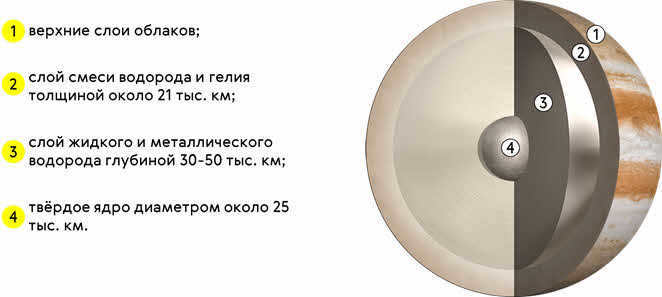
The solid core of Jupiter, located at its center, is composed of silicon oxides, magnesium, and iron with impurities. It has a diameter of approximately 25,000 kilometers.
As of 2016, Jupiter boasts a total of 67 natural satellites. Among them, the four largest – Io, Europa, Ganymede, and Callisto – were first observed by the renowned Italian scientist Galileo Galilei, earning them the name Galilean satellites.
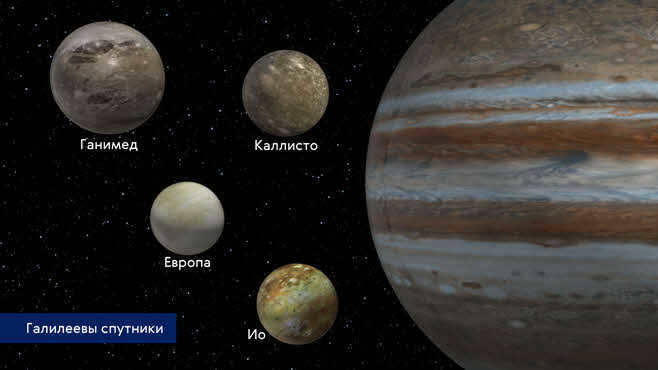
The sizes of Io and Europa are similar to that of our Moon, while Ganymede and Callisto are comparable in size to Mercury. It is evident that these satellites are distinct from one another. Moreover, each satellite possesses its own unique characteristic. For instance, active volcanoes have been discovered on Io. The surface of Europa, on the other hand, is surprisingly smooth and adorned with a complex network of delicate curved lines. Ganymede’s surface is marked with long furrows, the origin of which remains unclear. Lastly, the icy surface of Callisto is adorned with impact craters of various sizes.
In addition, spacecraft have uncovered the presence of a narrow ring composed of small dust particles encircling Jupiter.
In July 1994, an extraordinary event occurred in the heavens: Jupiter experienced a remarkable encounter with the Shoemaker-Levy comet. A series of 20 fragments collided with the gas giant, leaving a lasting impact on the planet’s surface. The most significant collision resulted in an explosion of unimaginable proportions, likened to the detonation of an astounding 6 million megaton bombs.
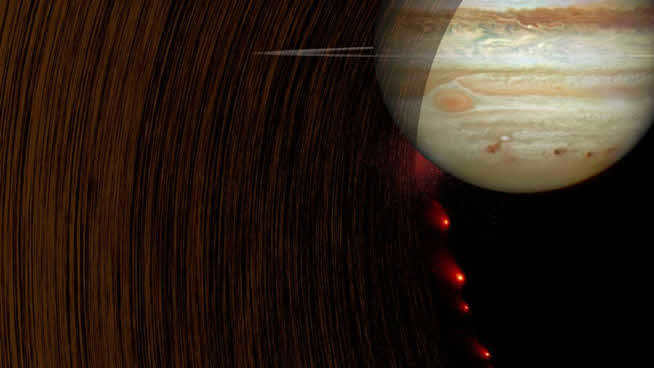
Saturn, the stunningly beautiful sixth planet from the Sun and the second largest in our solar system, is known as the heavenly body named after the Roman god of agriculture.
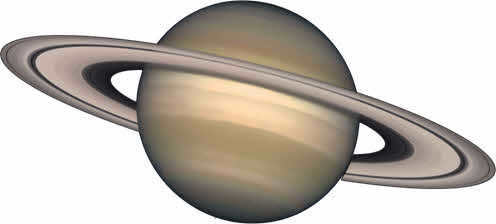
Most people are familiar with Saturn because of its remarkable rings. Throughout history, astronomers believed that Saturn was the sole planet to possess rings. However, it is now known that all four gas giants have rings.
Saturn is an enormous planet, slightly smaller than Jupiter but sharing many similarities with it. Saturn has a volume that is 800 times that of Earth. The planet completes one full rotation on its axis in just over 10.5 hours and takes nearly 29.5 Earth years to orbit the Sun.
Due to its rapid rotation, Saturn’s disk is visibly flattened at the poles. This is a result of Saturn having the lowest density of any planet in our solar system.
The upper atmosphere of Saturn is composed of over 96% hydrogen, with the remaining portion consisting of helium, methane, ammonia, and other gases.
As per the Voyager missions, Saturn experiences powerful winds reaching speeds of up to 500 meters per second. Similar to Jupiter, Saturn’s atmosphere occasionally gives rise to stable structures in the shape of exceptionally strong hurricanes.
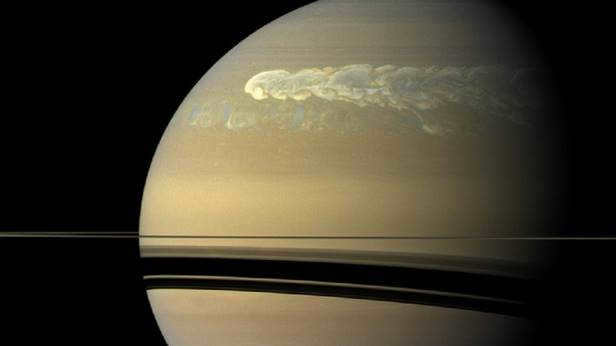
At great depths within the planet, the combination of high pressure and temperature leads to the transformation of hydrogen into a liquid form. It is interesting to note that at around 30,000 depths, hydrogen undergoes a remarkable change and becomes metallic. This unique property of metallic hydrogen is responsible for the generation of strong currents, which in turn create the planet’s magnetic field. In fact, the strength of this magnetic field is comparable to that of the Earth’s magnetic field.
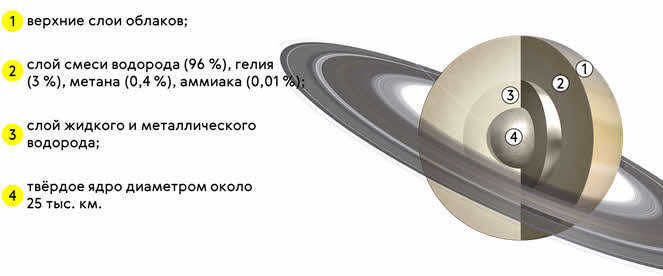
The core of the planet is located in its center and is composed of silicates, metals, and possibly ice.
One of the most prominent features of Saturn is its rings, which were initially observed by Galileo in 1610. However, he mistakenly believed them to be satellites of the planet. It was later discovered by Huygens that the rings actually belong to Saturn. This realization came 46 years after Galileo’s initial observations.
The rings of Saturn are comprised of numerous thin rings, as revealed by images captured by the Voyager-2 spacecraft. Each ring is made up of countless fragments of ice, ranging in size from tiny dust particles to several meters in diameter.
Currently, Saturn has a total of 62 natural satellites, with 53 of them having their own individual names.
The inner satellites of Saturn, namely Mimas, Enceladus, Tefia, Dione, Rhea, and Japetus, are all smaller than our Moon and are characterized by numerous craters on their surfaces.
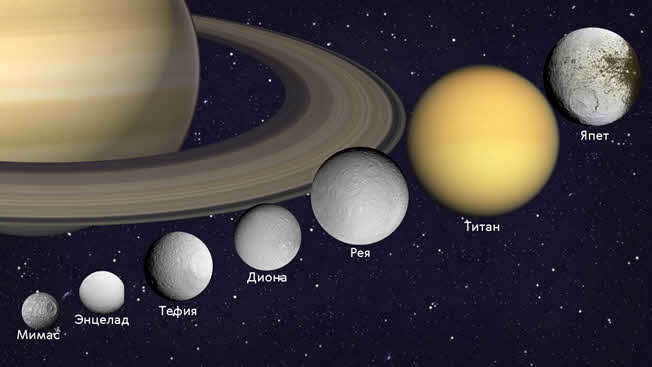
Titan, the largest moon of Saturn, stands out from other satellites because it possesses a notable atmosphere. This atmosphere is predominantly composed of nitrogen, but it also contains traces of methane and ethane which form clouds.
Uranus, the seventh planet from the Sun in terms of distance and the third largest in terms of diameter, was first observed by William Herschel in 1781. It was named after Uranus, the Greek god of the sky. The planet’s striking turquoise hue adds to its allure.
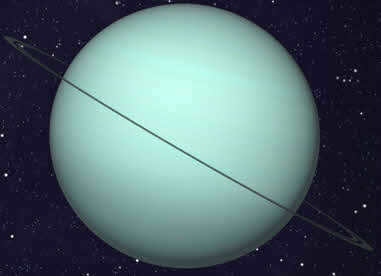
The phenomenon is caused by the combination of the planet’s atmospheric components and its temperature. With a temperature of approximately -217 ℃, Uranus’s hydrogen-helium atmosphere has developed a methane haze in its upper layers. This haze effectively absorbs red rays while reflecting blue and green rays.
Compared to Saturn and Jupiter, Uranus is a smaller planet located further away from the Sun. It has a unique characteristic of having its axis of rotation tilted more than 90° to its orbital plane, resulting in a sideways rotation.
Uranus completes its orbit around the Sun in 84 Earth years, while its rotation around its axis takes just over 17 hours.
The commonly accepted theory about Uranus proposes that it is composed of three main components: a central rocky core, a middle layer of icy material, and an outer atmosphere made up of hydrogen and helium, with a layer of methane clouds covering the surface.
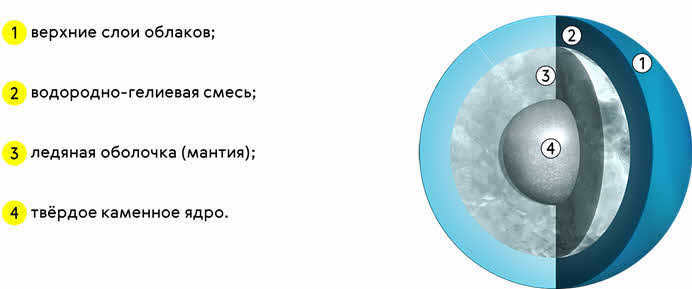
The majority of the planet is composed of ice, accounting for approximately 60% of its total radius. However, the ice shell on Uranus is not your typical frozen water, but rather a hot and dense liquid mixture of water, ammonia, and methane. With temperatures reaching as low as -224 ℃, Uranus holds the title for being the coldest planet in our solar system.
Uranus boasts a total of 27 natural satellites, all of which have been named after characters from the literary works of William Shakespeare and Alexander Pope. Among the largest satellites are Puck, Miranda, Ariel, Umbriel, Titania, and Oberon.
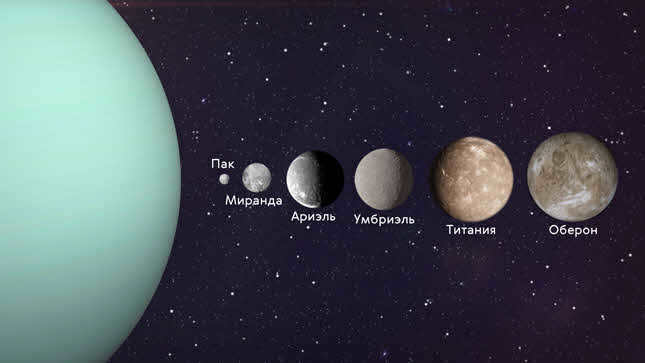
In 1977, scientists discovered that the planet has an additional feature – a series of delicate rings. These rings were later confirmed to exist through photographs taken by the Voyager 2 spacecraft. Made up of small, dark particles ranging in size from micrometers to fractions of a meter, these rings add to the unique characteristics of the planet.
Last but not least, Neptune is the eighth and final major planet in our solar system.
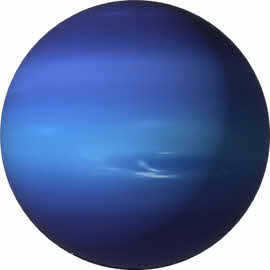
Neptune is the smallest among the giants and it is located near the outermost region of our solar system. It cannot be seen with the naked eye. Neptune has a mass that is 17.2 times greater than Earth and its equatorial diameter is almost 4 times larger. This planet was named after the Roman god of the seas. It takes Neptune approximately 165 Earth years to orbit the Sun, and it completes a full rotation around its axis in about 16 Earth hours.
Neptune was discovered on September 23, 1846, making it the first planet to be found through mathematical calculations. Its composition is very similar to that of Uranus. However, Neptune experiences the strongest winds in its atmosphere, with speeds reaching up to 2100 km/h.
The temperature in Neptune’s upper atmosphere is close to -220 ℃, but it increases to 5000 ℃ towards the center of the planet.
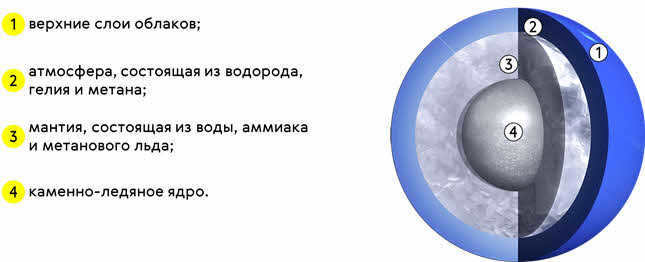
Neptune possesses its own magnetic field, which is approximately three times less powerful than that of Earth. Similar to all gas giants, Neptune features a ring system consisting of five distinct components.
Additionally, Neptune boasts a total of 14 satellites, with the largest one being Triton, named in honor of the ancient Greek deity of the oceans. Interestingly, this specific moon was detected by William Lassell merely 17 days subsequent to the initial discovery of the planet itself.
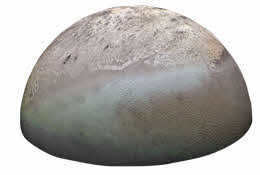
One interesting feature of Neptune is its impressive Great Dark Spot, which bears a resemblance to Jupiter’s renowned Great Red Spot.

In the preceding modules, we have acquired knowledge about the composition and properties of the rocky planets. The following video lesson will be centered on an in-depth investigation of the remaining four massive planets. We will delve into the distinctions between the giant and rocky planets. We will gain an understanding of the peculiarities of the giant planets’ rotational behavior. Additionally, we will examine specific aspects of the giant planets’ structure. Finally, we will uncover the mysteries surrounding planetary rings.
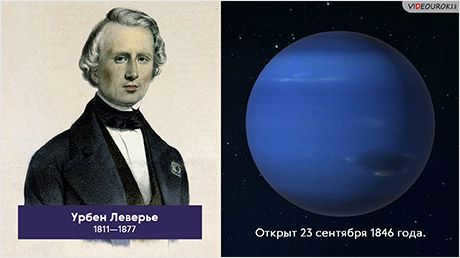
Currently, it is not possible to view or share the video tutorial with students
In order to access this and other video tutorials from the collection, you will need to add it to your personal account.
Unlock amazing possibilities



Outline of the Lesson on Giant Planets
As we know, our solar system consists of eight major planets. Based on their size, mass, and overall structure, they are typically categorized into two groups: the terrestrial planets, which are located inside the main asteroid belt, and the giant planets, which are found outside of it.
In our previous lessons, we have explored the structure and characteristics of the terrestrial planets: Mercury, Venus, Earth, and Mars. Today, we will delve into a comprehensive study of the remaining four planets, starting with the largest member of the solar system, Jupiter. This planet was named after the supreme deity of ancient Roman mythology.
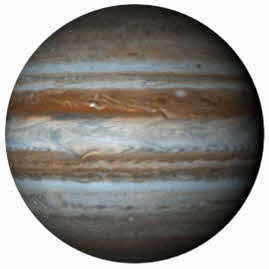
Jupiter has been a familiar sight in the night sky since ancient times, visible to the naked eye. It is one of the brightest objects in the night sky, surpassed only by the Moon and Venus.
Jupiter is known as a gas giant for good reason: it has an average radius of 11.2 times that of Earth, measuring 69,911 kilometers. The planet’s mass is even more impressive, weighing nearly 2.47 times the combined mass of all the other planets in our solar system. In fact, Jupiter’s mass is 317.8 times greater than that of Earth. Despite its massive size, Jupiter’s average density is relatively low at 1.326 g/cm3. This is due to its composition as a gaseous body, with a thick atmosphere primarily composed of hydrogen and helium.
The average distance between the Sun and Jupiter is slightly more than 5 astronomical units (a.u.). Jupiter completes one orbit around the Sun in approximately 11.89 Earth years. However, Jupiter’s rotational speed is incredibly fast, with a day on Jupiter lasting only 9.925 Earth hours. This rapid rotation causes the planet’s clouds to form distinct bands parallel to the equator. Wind speeds on Jupiter can reach up to 600 kilometers per hour.
Similar to other gas giant planets, Jupiter exhibits light and dark oval-shaped features known as cyclones and anticyclones, which can persist in the planet’s atmosphere for hundreds of years. The most well-known of these formations is the Great Red Spot, which was first observed by Robert Hooke in 1644. This hurricane-like storm is significantly larger than Earth in size.
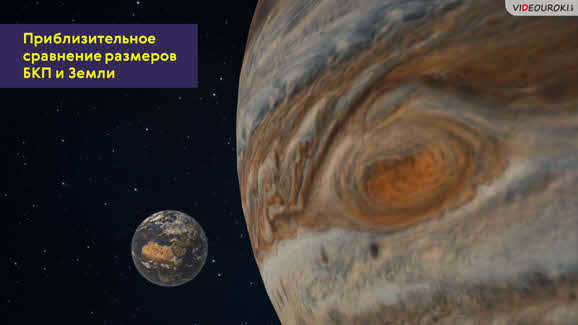
In December 1995, Jupiter’s atmosphere was explored by the Galileo probe. The collected data led to the development of a model explaining the planet’s structure. According to this model, the outermost layer is the atmosphere, predominantly composed of hydrogen and helium. The temperature in this layer is estimated to be around -130°C under a pressure of one atmosphere.
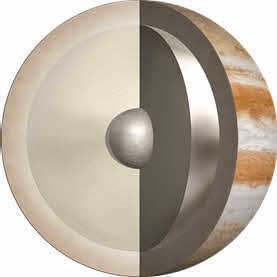
There might be a rocky core at the center of Jupiter, measuring approximately 25,000 kilometers in diameter.
Jupiter currently holds the record for having the highest number of known satellites among all the planets in our solar system, with a total of 69 satellites as of 2017.
In 1979, during its journey, the Voyager 1 spacecraft flew past Jupiter and made a surprising discovery – the presence of three faint rings composed of tiny dust particles surrounding the planet.
A rare and remarkable event occurred in the sky during July 1994 when comet Shoemaker-Levy 9 collided with Jupiter. A total of 20 fragments from the comet crashed into the planet, resulting in an explosion equivalent to the detonation of 6 million megaton atomic bombs when the largest fragment hit.
Saturn, the sixth planet from the Sun and the second largest planet in our solar system, gets its name from the Roman god of agriculture.
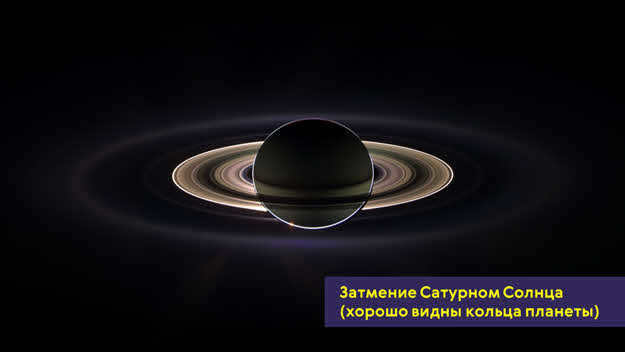
Saturn is widely known for its magnificent rings, which have captivated the attention of people for centuries. In the past, astronomers believed that Saturn was the only planet in our solar system to possess such rings. However, it is now known that all four gas giants, including Jupiter, Uranus, and Neptune, also have these fascinating features.
Similar to its larger counterpart Jupiter, Saturn is a massive planet. It has an average radius of 58,232 kilometers and a mass that is 95 times greater than that of Earth. Despite its immense size, Saturn has a surprisingly low average density of only 0.687 g/cm3, which is less than that of water. This makes it the only planet in our solar system with a density lower than water.
Saturn is located at an average distance of 9.58 astronomical units (a.u.) from the Sun. As a result, it takes approximately 29.5 years for Saturn to complete one revolution around the Sun. The planet also has a relatively fast rotation period, with an average duration of 10 hours, 32 minutes, and 45 seconds.
The spacecraft Voyager-1 and Voyager-2 have documented strong hurricane winds on Saturn, with speeds reaching 500 meters per second. The outer layers of the planet’s atmosphere consist of 96.3% hydrogen and 3.25% helium. The temperature in the upper layer of the atmosphere is extremely low, measuring -170°C.
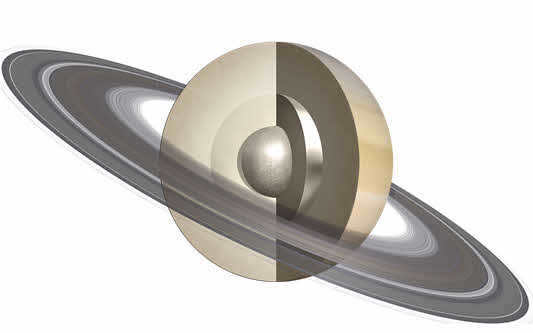
However, in the depths of Saturn’s atmosphere, pressure and temperature increase and cause hydrogen to transition into a liquid state. At a depth of approximately 30,000 kilometers, the hydrogen undergoes a transformation and becomes metallic. At the core of the planet lies a massive composition of silicates, metals, and potentially ice.
During a flyby near Saturn in the 1980s, the Voyager 1 spacecraft observed a peculiar and stable atmospheric formation at the planet’s north pole. This formation took on the shape of an almost perfect hexagon, measuring about 25,000 kilometers in width. Despite extensive research, scientists have yet to offer a definitive explanation for this intriguing atmospheric phenomenon.
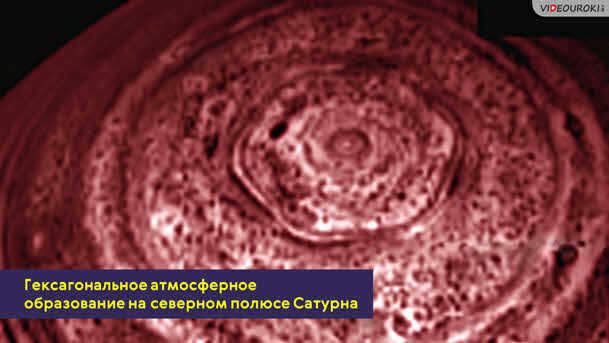
Saturn is most famously known for its rings, which were initially mistaken for satellites by Galileo in 1610. However, it was Huygens who eventually credited with the discovery of Saturn’s rings, 46 years after Galileo’s initial observations.
Interplanetary spacecraft images have revealed that Saturn’s ring system is composed of thousands of delicate rings, each made up of billions of minuscule particles ranging in size from one centimeter to ten meters. Despite their vast diameter of approximately 250,000 kilometers, the rings themselves are incredibly thin, measuring no more than one kilometer in thickness.
As of 2017, Saturn boasts a total of 62 confirmed natural satellites, each with their own confirmed orbits.
Uranus, which is situated around 19.23 a.u. away from the Sun, holds the seventh position in terms of distance from the Sun. It is also the third largest planet in diameter and the fourth largest planet in mass within our solar system. This celestial body was first observed by William Herschel on March 13, 1781 and was given the name Uranus after the Greek deity of the sky (making it the only major planet to be named after a Greek mythological figure rather than a Roman one).
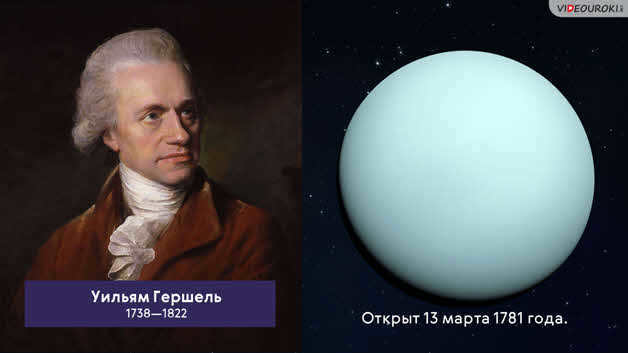
Uranus completes one orbit around the Sun every 84.01 Earth years and has a rotation period of 17 hours, 14 minutes, and 24 seconds around its axis. Unlike other planets that can be compared to rotating wolves, Uranus is more similar to a rolling ball. This is due to the fact that the planet’s equator is inclined at an angle of 97.86 degrees to the plane of its orbit. As a result, the planet rotates in a retrograde motion, almost lying on its side and slightly upside down.
The average radius of Uranus is 25,362 kilometers. It has a mass 14.6 times that of Earth, but its average density is only 1.27 g/cm3.
Unlike Saturn and Jupiter, which are primarily made up of hydrogen and helium, Uranus, similar to Neptune, lacks metallic hydrogen within its core. Scientists believe that Uranus houses a solid rocky core at its center, encompassed by vast quantities of ice in different forms.
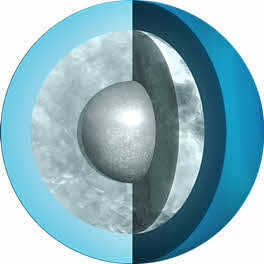
Ice accounts for the majority of the planet’s composition (up to 60% of the total radius). This discovery has led scientists to classify it (alongside Neptune) as an “ice giant”. It’s important to note, however, that the ice shell is not your typical frozen water, but rather a hot and dense liquid mixture of water, ammonia, and methane.
The planet’s atmosphere is primarily composed of helium and molecular hydrogen, and is topped by a layer of methane clouds, which, interestingly enough, give Uranus its delightful turquoise hue.
As of early 2017, astronomers have identified 27 natural satellites orbiting Uranus. Similar to other gas giants, Uranus also possesses a faint and narrow ring system.
Neptune, the final major planet in the solar system, is located approximately 30.10 astronomical units away from the Sun. It derives its name from the ancient Roman god associated with the seas.
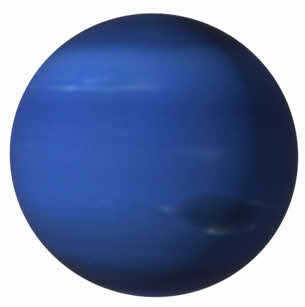
Neptune, which is a part of the giant planets, is the smallest among them. It has a mass that is 17.2 times greater than Earth and an equatorial diameter that is 3.9 times larger. The planet’s average density is 1.638 g/cm 3 , which is similar to other giant planets.
Neptune takes approximately 164.79 Earth years to orbit around the Sun. Its rotation period around its axis is 15 hours, 57 minutes, and 59 seconds.
Interestingly, Neptune was the first planet to be discovered through mathematical calculations, known as “at the tip of a pen.” It was discovered after midnight on September 24, 1846.
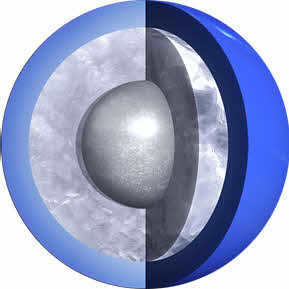
At a depth of approximately 7000 kilometers, methane undergoes decomposition and forms diamond crystals, which precipitate onto the iron-nickel core of the planet.
As of 2017, there have been 14 natural satellites discovered around Neptune. Interestingly, the largest satellite of Neptune, Triton, was detected by British astronomer William Lassell just 17 days after the planet’s discovery. Additionally, similar to other giant planets, Neptune possesses a ring system consisting of five components.
Giant planets, also known as Jupiterian planets, include Saturn, Neptune, Uranus, and Jupiter.
Jupiter, the largest planet in the Solar System, is the fifth farthest from the Sun, located at a distance of 5.2 astronomical units. This planet emits thermal radio radiation, has a radiation belt, and a vast magnetic field. Jupiter has a total of 69 satellites and a ring approximately 6,000 kilometers wide.
Saturn, the second largest celestial body in our solar system, is adorned with a stunning set of rings that can be clearly observed through a telescope. These magnificent rings were first observed by Galileo in the 17th century, during the time he constructed his remarkable telescope. The rings themselves boast a flat shape and are accompanied by a multitude of small satellites, totaling to an impressive count of 62 satellites. Additionally, Saturn possesses its own radiation belt, adding to its unique characteristics.
On the other hand, Neptune, the planet farthest from the Sun among the planets under consideration, is approximately 30 astronomical units away. With a rotation period of nearly 165 years, Neptune is an intriguing celestial body. It is accompanied by 6 satellites. Due to its considerable distance from Earth’s surface, exploring Neptune proves to be quite a challenging endeavor.
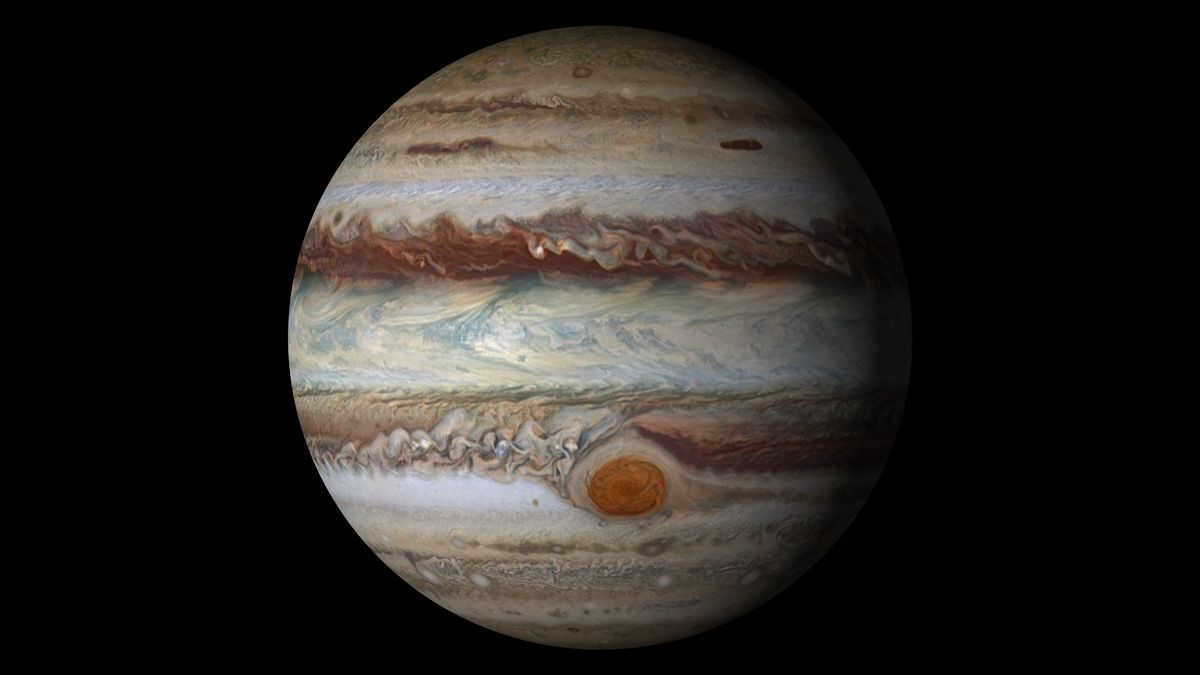
Distinctive Features of the Giant Planets
All the planets within this classification, particularly Jupiter, possess immense mass and size. To illustrate, Jupiter is approximately 1,500 times larger than our home planet in terms of size, and over 300 times larger in terms of mass.
All of these planets rotate on their own axes at relatively high velocities. For instance, the colossal Jupiter completes a full revolution in less than a dozen hours. Throughout this time, the equatorial zone experiences a greater rate of revolution compared to the polar zone, meaning that the maximum linear displacement of a point during its axial rotation corresponds to the maximum angular displacement. The consequence of the substantial orbital velocity is that the giant planet becomes highly compressed, which is evident by a simple observation.
A massive celestial body resides in the outer reaches of our solar system, where the temperature remains consistently low regardless of the changing seasons. Take Jupiter, for example, its seasons remain static due to its axis being nearly perpendicular to its orbital plane. Uranus, on the other hand, experiences intriguing seasonal variations as its axis is inclined at an angle of 8 degrees to its orbital plane.
An outstanding characteristic of these planets is the abundance of their satellites. In 2001, Jupiter boasted 28 satellites, Saturn had around 36, Uranus had 21, and Neptune had a comparably small number of 8. One fascinating feature common to these giant planets is their ring system, which is not exclusive to Saturn but can also be found orbiting other planets in this category.
One of the primary characteristics of a massive planet is its lack of a solid surface. This attribute aligns with the low average densities of these planets. As a result, all the observable phenomena in these gigantic planets occur within their respective atmospheric layers. On the exterior of Jupiter, one can observe bands stretching across its equatorial region. Within the uppermost layer of Jupiter, which is composed of helium and hydrogen, one can detect chemical compounds, hydrocarbon elements, and various substances that impart brown, reddish, and yellow hues to the atmospheric components as impurities. In this regard, in terms of chemical properties, planets of this classification differ significantly from terrestrial counterparts.
By studying the characteristics of the planets in the Jupiterian group, we can identify the main shared properties of each representative:
- They lack a solid shell.
- They have a tremendous volume, mostly composed of hydrogen compounds.
- Despite their enormous masses, they have extremely low densities.
- They experience such high axial velocities that they become compressed.
- They possess ring systems.
- They have numerous satellites.
How are giant planets distinct from Earth-group planets?
Earth-group planets exhibit notable distinctions from giant planets, primarily in their physical characteristics. These disparities are primarily attributed to the difference in distance from the Sun and the mass of these celestial bodies.
Earth-group planets are situated at a closer proximity to the Sun, resulting in a higher influx of solar energy and greater susceptibility to temperature elevation. The closer a planet is to the center of the solar system, the more extreme its temperature conditions become. Furthermore, the chemical composition of these planets also sets them apart. Earth-like planets possess a lower quantity of light gases but a higher abundance of refractory elements. On the other hand, planets like Jupiter have a lower density due to their composition primarily consisting of lighter substances like helium and hydrogen.
The mass of a planet is determined by the presence and properties of its atmosphere on the surface. The greater the mass, the stronger the planet’s gravity. If the gravitational force weakens, the planet will lose its atmosphere at a faster rate. The composition and density of the atmosphere depend on the distance from the center of the solar system.
Planets in the Jupiterian group rotate at a higher speed around their axis compared to other planets. Their rapid rotation causes them to have a compressed shape, rather than a spherical one. These giant planets also have a large number of satellites and ring systems, which is not the case for Earth-like planets. Earth has only one satellite, while Mars has only two satellites.
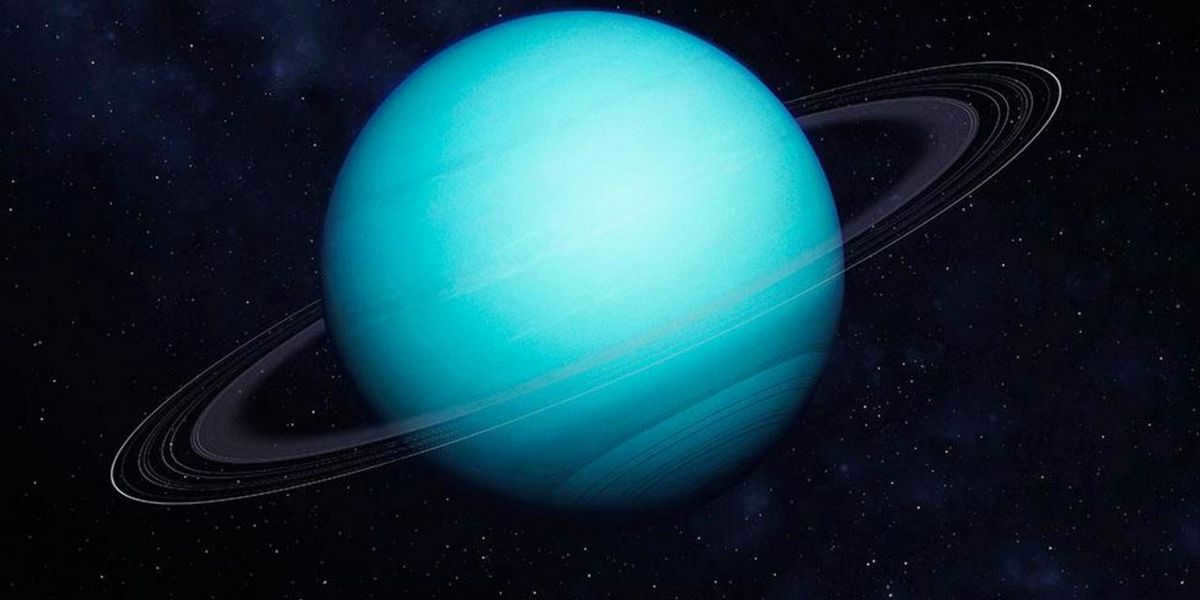
Characteristics of the colossal planets
The weight of each of the representatives of this group is multiple times greater than the combined weight of all representatives of the Earth-like type. However, the density of colossal planets is extremely low, not even surpassing that of water. This is because planets like Jupiter are essentially enormous gas spheres. Consequently, it is impossible for anyone to step foot on the surface of any of them. Nevertheless, due to the intense compression of the planet caused by gravity, colossal planets possess a solid core with a frozen crust.
One of the distinguishing features of the planets in the Jupiterian group is the presence of rings that contain a multitude of celestial objects.
The atmospheric composition of the massive planets
The external representation of the shell of the giant planets remains unknown. In the upper layers of their atmospheres, only bands of clouds are visible, which extend along the equator due to the planet’s rotation. The atmospheres of the Jupiterian group of planets are primarily composed of ammonia and methane particles, with hydrogen also present. Hydrogen is the predominant component of these planets, particularly Jupiter. The interior of these planets is highly compressed, with a density tens of times greater than water. Scientists theorize that the shell of the giant planets consists of frozen ice and gases. This is likely due to the extreme temperatures in the atmospheric layers, which reach 138 degrees below zero. Furthermore, for planets located further from the solar system’s center, these temperatures are even lower.
Satellites of colossal planets
Each planet within this category possesses its own satellites, and in abundant quantities. Jupiter and Saturn, in particular, boast an impressive assortment of such celestial bodies. Moreover, new satellites are continuously being unearthed and investigated, leading to a constant expansion in their numbers. The minimum sizes and masses of these satellites have yet to be definitively determined, resulting in these measurements being somewhat approximate for Saturn: if an object with a diameter of around 30 meters is detected in close proximity to Saturn, should it be classified as a satellite or merely part of the ring system?
Each small satellite bears multiple impact marks. This phenomenon occurs due to occasional collisions between satellites themselves and other celestial bodies that happen to occupy the same space. These collisions can result in fragmentation or, conversely, merging of particles. Consequently, determining the historical origin of these satellites is extremely challenging. However, amidst the multitude of satellites, there are those that are genetically linked to the planet, as their movement takes place near the planet’s equatorial plane. Hence, it is highly probable that such satellites share a common origin with the planets they are tethered to.
The most fascinating objects are the large satellites of planets. Jupiter possesses four of these satellites, while Saturn possesses one. These satellites possess nearly indistinguishable properties from regular planets. The distinction lies in their movement, as they are not only influenced by the sun but also by their respective larger planets.
Rings of the giant planets
It is common knowledge that Saturn is the planet known for its ring. However, a closer examination reveals that all the planets belonging to the group of Jovian planets possess rings. These rings are not visible from the surface of Earth. For instance, Jupiter’s ring cannot be observed through a telescope, but it can be seen using backlighting when a probe captures a view of the planet from the opposite side of the day. Jupiter’s ring system consists of small, dark sections that are approximately the size of a light wave. They have minimal light-reflecting capabilities, but are capable of scattering light.
Neptune and Uranus have thin rings. In reality, these planets do not have identical rings; each possesses unique characteristics. In a lighthearted manner, it can be said that even our planet has its own ring, albeit a man-made one comprised of numerous satellites in orbit.
The ring thickness at the enormous diameter of thousands of kilometers is remarkably minute. If we were to compare Saturn’s ring system to a sheet of paper, it would be as thin as a soccer field.
Each colossal planet possesses its own ring, the genesis of which remains undetermined by science. Typically, the rings are situated at the equator and revolve in synchronization with the planet.
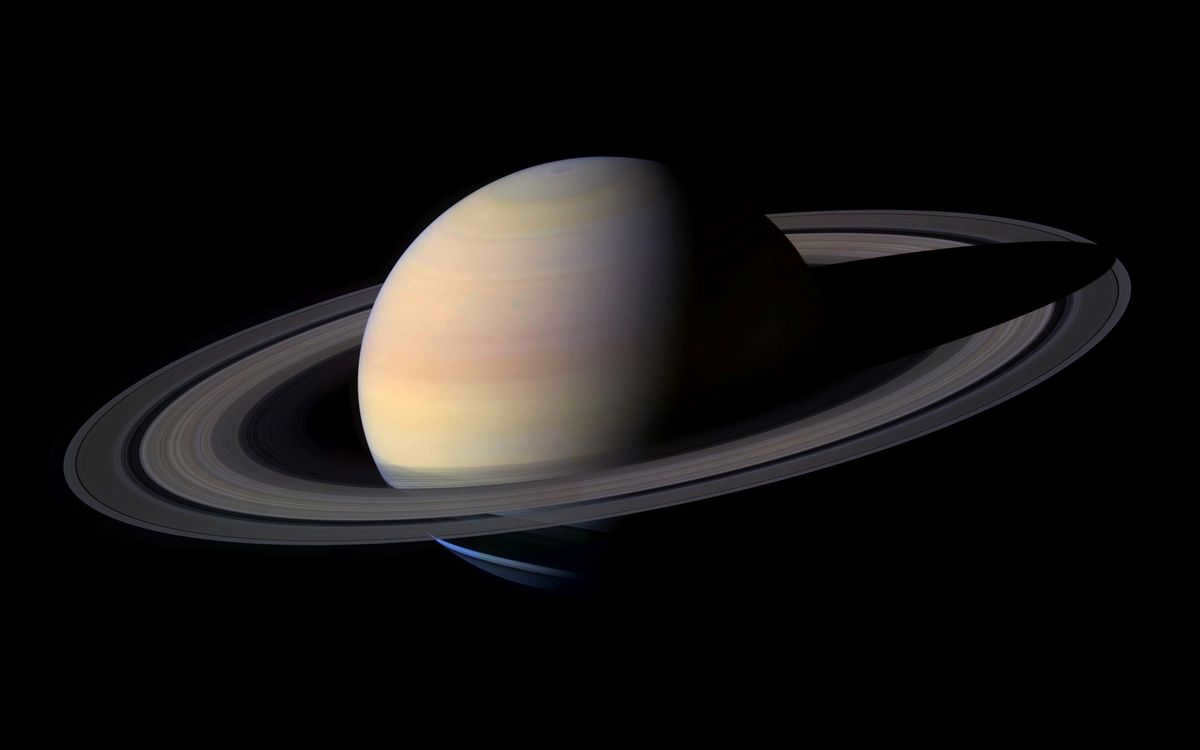
Unique Surface Characteristics of Giant Planets
One interesting aspect of giant planets in our solar system is their lack of a solid surface. Instead, their atmospheres blend seamlessly into a liquid-like consistency. While these planets do have a relatively small core, it is significantly larger in volume compared to Earth-like planets.
Composition of the giant planets: an analysis of their chemical makeup
When it comes to the chemical composition of our giant planets, Saturn and Jupiter, it is dominated by lighter elements such as hydrogen and helium. On the other hand, Neptune and Uranus possess vast quantities of heavier elements like ammonia, methane, and a few others. While these planets do contain additional components, their proportions are significantly lower. Scientists have made an intriguing discovery that as the mass of a planet increases, so does its atmospheric layer. Consequently, with the exception of Saturn, all the planets in our system have extensive atmospheres that share similar parameters. The variations in the list of chemical elements present in each object can be attributed to the evolutionary development of our planetary system.
Structure and Density of Giant Planets
As previously mentioned, the distinctive characteristic of Jupiter-like planets is the absence of a solid shell and the presence of light elements such as helium and hydrogen. All observable phenomena occur within their atmospheric layers. Jupiter, for instance, displays visible streaks along its equator that can be observed even with small telescopes. These streaks continue into the higher atmospheric layers where various elements impart different shades to the atmosphere. The density of giant planets is significantly lower compared to Earth-like planets.
Massive planets are commonly known as giant planets. They can exist in either solid or gaseous form. Within our solar system, Jupiter and Saturn are classified as gas giants. On the other hand, Neptune and Uranus are referred to as ice giants.
The categorization into ice and gas giants is a relatively new concept in the field of astronomy. In earlier textbooks, Jupiter, Saturn, Uranus, and Neptune were all grouped together as gas giants.
Characteristics and Structure of Giant Planets
Giant planets, unlike the Earth group planets, are characterized by their massive size and high mass. The pressure within their interiors is significantly greater than that of Earth. Additionally, their atmospheres are more expansive and powerful, and they rotate at a faster rate.
Moreover, giant planets are known for having a larger number of satellites and rings. These rings are flat disks composed of ice and dust that orbit around the planet’s equator.
The primary constituents of Saturn and Jupiter are helium and hydrogen, whereas Neptune and Uranus are predominantly composed of methane, ammonia, and water.
Comparison and Contrast, Table, Concise Description
The solar system’s giant planets exhibit both similarities and differences. Each planet possesses distinct physical characteristics, properties, and temperature regimes.
Jupiter
Jupiter, which is 318 times more massive than Earth, boasts an extremely high internal temperature. Consequently, numerous vortex structures are observable in its atmosphere, including the well-known red spots and cloud bands.
The planet is accompanied by 79 satellites, with the largest ones being Callisto, Europa, Io, and Ganymede. These satellites resemble terrestrial planets due to their volcanic activity and luminous cores.
Ganymede, Jupiter’s permanent satellite, surpasses Mercury in both mass and size, making it the largest satellite in the entire solar system.
Saturn
Saturn weighs 95 times more than Earth. It is the least dense planet in our solar system and has a similar structure and composition to Jupiter.
Scientists have confirmed the existence of 82 satellites orbiting Saturn. Two of these satellites, Enceladus and Titan, show signs of geologic activity. However, this activity is different from Earth’s as it is caused by processes occurring in ice, rather than rocky rocks.
Saturn is famous for its rings, which form a complex structure with large gaps and barely visible splits.
Uranus is the lightest of the gas giants, but its mass is still 14 times that of Earth. What makes Uranus unique is its rotation, as it spins on its side with a rotation axis tilted 98 degrees relative to the ecliptic plane.
One more characteristic of Uranus is its frigid core, which results in the emission of extremely small amounts of heat into outer space.
Neptune
Neptune, on the other hand, is smaller in size compared to Uranus, but it surpasses it in terms of mass – this figure is 17 times that of Earth. Neptune is dense, emits heat, has 14 satellites, and a number of Trojan asteroids that are in orbital resonance with it.
The largest of these satellites is Triton. It is of particular interest to scientists due to its retrograde motion, liquid nitrogen geysers, and geological activity.
A massive celestial body is what it truly is
Based on their composition and distance from the Sun, celestial objects can be classified into two categories:
- The outer giant planets are situated beyond the orbit of Mars and extend past the asteroid belt. Due to their greater distance, they take longer to complete one orbit around the Sun. These giants are distinguished by their unique structure, rotational characteristics, the presence of moons and rings. They play a crucial role in shielding the Earth from potential meteorite impacts.
- The smaller inner planets are characterized by solid surfaces comprised of oxidized compounds. Among these inner planets, only Earth possesses a robust magnetic field that provides protection against the interplanetary environment.
What are the giant planets?
Astronomers classify certain planets as giants, which are believed to have originated from rocky and icy planets. These giant planets, such as Jupiter and Saturn, have a similar structure to Earth but with larger nuclei. This allows them to capture and accumulate hydrogen and helium from the surrounding gas cloud.
The size of the outer planets is several times larger than that of terrestrial bodies, and they lack solid surfaces, resulting in low densities. In fact, if a giant like Saturn were submerged in a massive bathtub, it would float on water. Additionally, each of these outer planets possesses a strong magnetic field, a system of rings, and numerous satellites.
Which planets in the solar system are considered giants?
Only four planets in the solar system are classified as giants.
Jupiter, the largest of the giant planets, has a radius approximately 11 times that of Earth. It is accompanied by around 80 satellites and is composed of a dense core of rock and ice surrounded by a cloud of hydrogen and helium. Jupiter has been visible to the naked eye since ancient times.
Saturn, another giant planet, is known for its distinctive and expansive rings. The origin of these flat concentric formations remains a mystery. Saturn has 62 confirmed satellites and its atmosphere is similar to that of Jupiter.
Uranus, with a radius four times that of Earth, is the only giant planet that rotates in the opposite direction. This massive celestial body is also recognized for its unusual tilt, as it essentially lies on its side. Uranus is accompanied by 27 satellites.
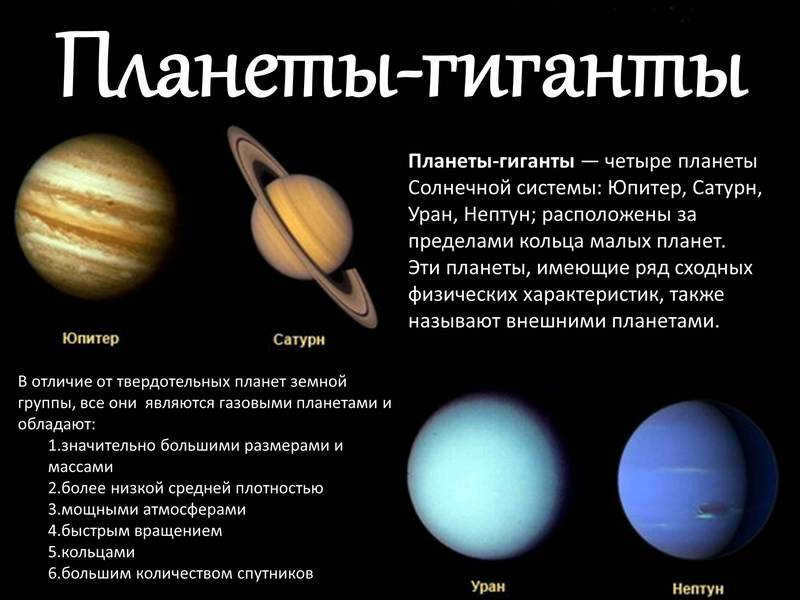
The structure of the massive planets
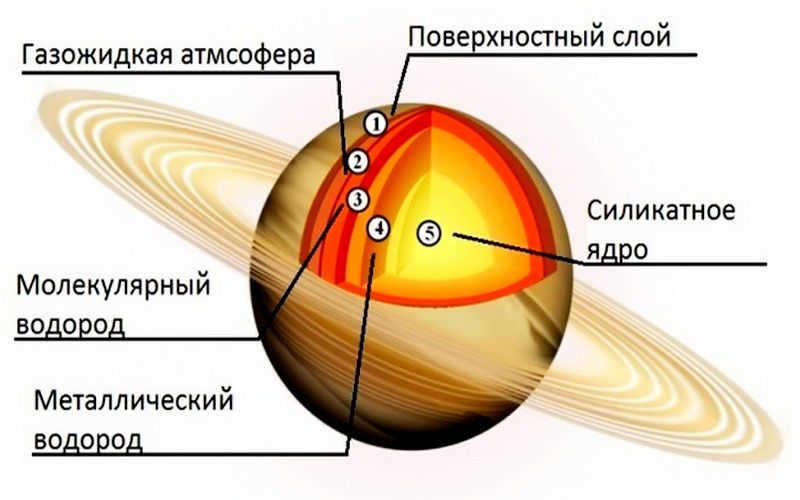
What are the astrological symbols used to identify the giant planets
Every giant planet has its own unique astrological symbol that has its roots in ancient paganism.
- The outer planets, being the farthest from the Sun, require a significant amount of time to complete their orbit around it. For instance, Jupiter takes nearly 12 years, while Neptune takes over 164 years. Additionally, the outer planets consistently experience frigid temperatures.
- The giants are known for their immense weight and colossal size. Jupiter, for instance, is 318 times heavier than Earth. Saturn is approximately 25% heavier than Jupiter, while Uranus and Neptune are only 5% heavier.
- The planets are able to complete a full rotation on their axis in a relatively short amount of time, ranging from 10 to 17 hours.
- The outer system’s representatives lack solid surfaces.
- The outer planets exhibit low density, which contributes to their relatively lighter weight considering their size.
- All giants possess satellites and rings that orbit around them. The rings consist of thin disks composed of dust and rocks. They are believed to have formed from either shattered or undeveloped satellites.
The enormities of the colossal planets
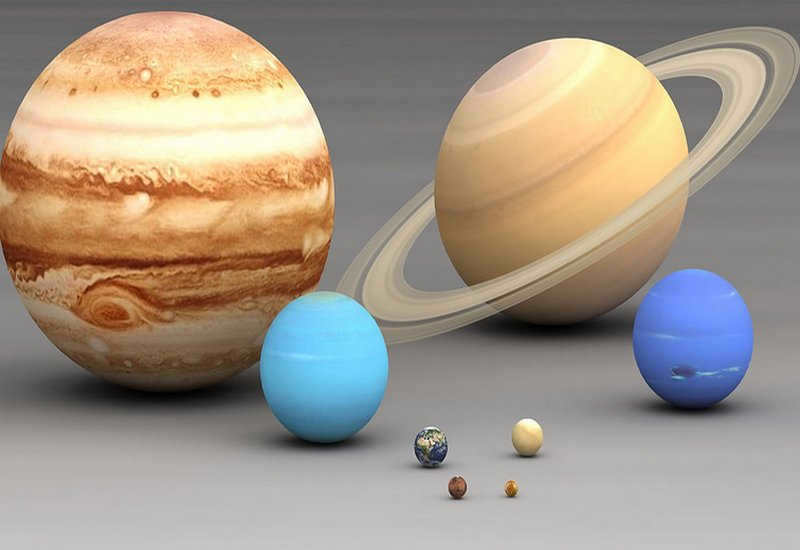
Analyzing the Elements Present in the Atmospheres of the Gigantic Planets
The two largest celestial bodies, Jupiter and Saturn, have nearly identical chemical compositions to that of the Sun. They are primarily composed of two elements, hydrogen and helium, with 75% of their mass consisting of hydrogen and 25% helium. On our planet, hydrogen and helium are gases, which is why Jupiter and Saturn are often referred to as gas giants. However, due to their immense size, the gases inside these planets are compressed to a liquid state. The majority of these giants’ mass is made up of liquefied hydrogen, earning them the name of liquid planets. The gravitational forces cause the heavier elements to sink towards the core of these liquid or gaseous planets.
On the other hand, Uranus and Neptune are significantly smaller than their counterparts, yet they each possess a core composed of rock, metal, and ice. These planets have much smaller atmospheres in comparison to their cores.
The outer planets are primarily dominated by hydrogen and its various compounds.
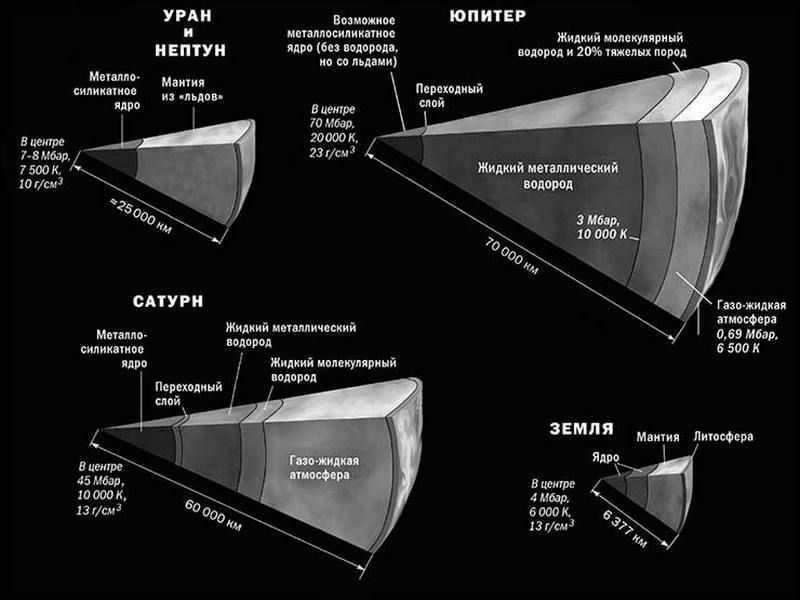
Chart of massive planets
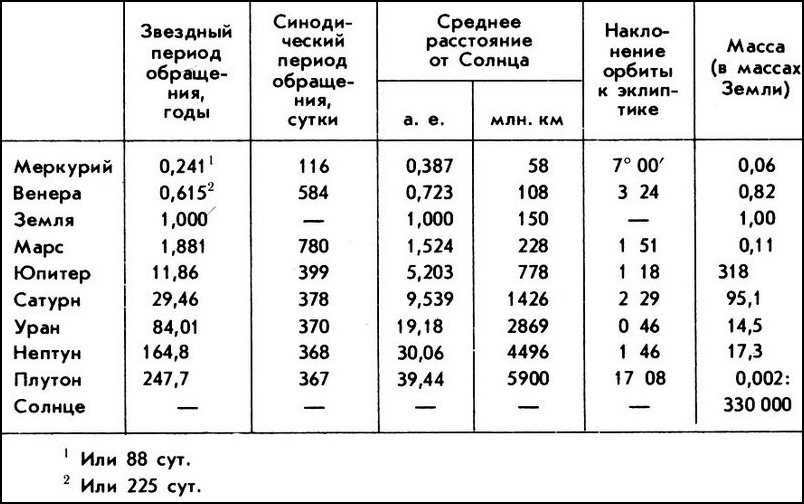
Subscribe to our newsletter and get access to exclusive stories delivered directly to your inbox!
Marie Smartypants
Here is the top response:
Surrikat Mimi
Surrikat Mimi are celestial objects characterized by their expansive atmospheres, rapid rotational motion, numerous satellites, and the presence of rings. Unlike terrestrial planets, the giant planets lack solid or liquid surfaces. The primary constituents of all giant planets consist of hydrogen and helium.
You have the ability to generate an animation (or even an entire cartoon!) by utilizing multiple illustrations. In order to achieve this, simply sketch out a series of sequential frames and then click on the “View Animation” button.
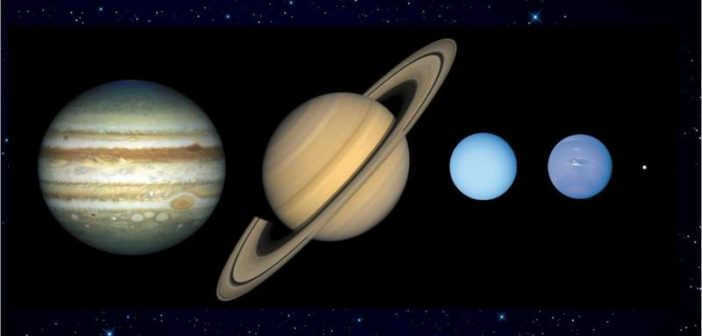
“Giant planets” are the second largest objects in the solar system after the Sun. In terms of mass, Jupiter is 317.8 times that of Earth, yet it completes one rotation on its axis in less than 10 hours. These gas giants do not experience seasons, and some of them have over 70 satellites. Today, let’s examine the key characteristics of these giants, their similarities, and notable distinctions.
There are two groups of celestial bodies, which are classified based on their composition and distance from the Sun:
- Outer giant planets are situated beyond the orbit of Mars and the asteroid belt. Due to their greater distance, they have a longer orbital period around the Sun. Giants have distinct characteristics such as their structure, rotation, satellites, and rings. They also play a crucial role in shielding Earth from meteoroid impacts.
- Small inner planets have solid surfaces composed of oxidized compounds. Among the inner planets, only Earth possesses a robust magnetic field that offers protection from the space environment.
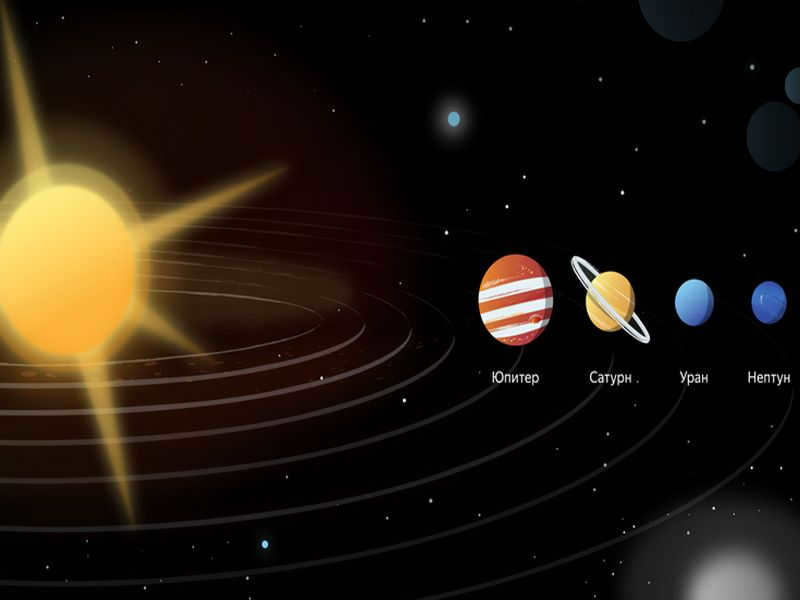
What types of planets are considered giant planets?
Astronomers speculate that the giants initially formed from rocky and icy planets. These planets had a similar structure to Earth’s, but their larger cores allowed giants (such as Jupiter and Saturn) to capture and accumulate hydrogen and helium from the surrounding gas cloud.
The outer planets are significantly larger than terrestrial bodies, resulting in lower densities. To illustrate, if the giant planet Saturn were submerged in a massive bathtub, it would float on the water’s surface. Each of the outer planets possesses a robust magnetic field, a system of rings, and numerous moons.
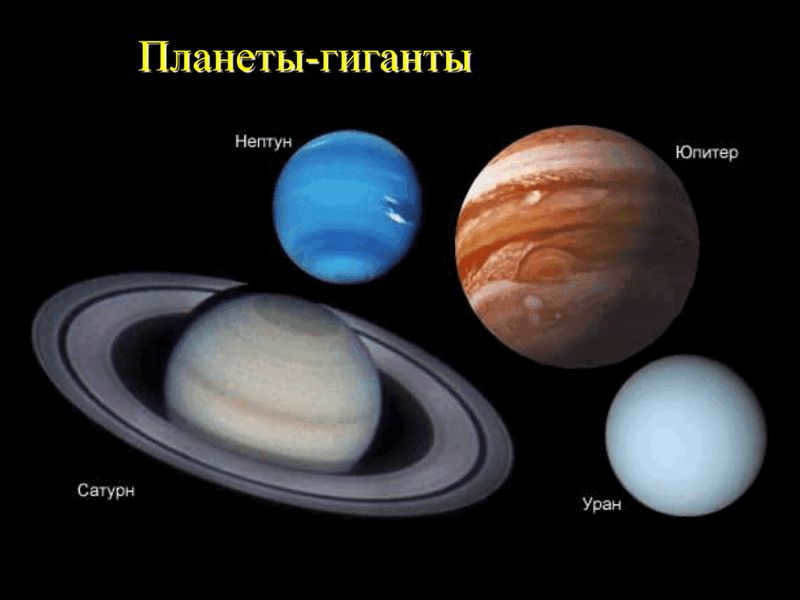
Which planets in the solar system are considered giants?
There are only four planets in the solar system that are classified as giants.
Jupiter, with a radius almost 11 times larger than Earth, is one of the giants. It is surrounded by a dense core of rock and ice, and its atmosphere is made up mainly of hydrogen and helium. Jupiter has around 80 satellites and has been visible to the naked eye since ancient times.
Saturn, another giant planet, is known for its distinctive, thin rings. The origin of these flat concentric formations is still unknown. Saturn has 62 confirmed satellites and a similar atmosphere to Jupiter.
The size of Uranus is four times larger than Earth. It is the sole giant planet that rotates in the opposite direction. The massive celestial object can also be distinguished by its unique tilt, as it literally lies on its side. Surrounding the giant are 27 satellites.
Neptune, on the other hand, shares a comparable size to Uranus. This giant planet has a total of 14 confirmed satellites. It was first discovered in 1846.

Structure of massive planets
"Gas giants" are known for their massive size, high mass, and low density. The majority of the gas surrounding their cores is made up of hydrogen, with a small amount of helium. It is believed that each of these planets has a central core made up of heavier materials, a fact that has been confirmed through detailed analysis of their gravitational fields. These cores consist of rocky and icy bodies that formed prior to capturing gas from the surrounding nebula. The pressure in the inner layer can reach tens of millions of bars. When scientists refer to "rock," they are referring to any material composed of iron, oxygen, and silicon. Ice bodies, on the other hand, include materials that are primarily made up of carbon, nitrogen, and oxygen combined with hydrogen.
The atmospheres of Jupiter and Saturn are dense and filled with layers of molecular and liquid-metal hydrogen. Uranus, on the other hand, has an icy layer that covers its solid rocky core, and this is further surrounded by a gaseous atmosphere. Neptune has an ammonia-water ocean that covers its rocky core.

What are the astrological symbols for the giant planets?
Each giant planet has its own astrological symbol, which has pagan origins.
- The supreme god Zeus, represented by the letter “Z,” is associated with Jupiter. The symbol is a vertical line intersected by a horizontal line. Another version of the symbol resembles the number “2,” representing duality.
- Saturn is associated with the god of agriculture, who has his own symbols – the sickle and the scythe. Some astronomers interpret the symbol of Saturn as a cross with a curl, representing strength and power.
- Neptune is represented by a trident, which symbolizes anger, cunning, and uncertainty.
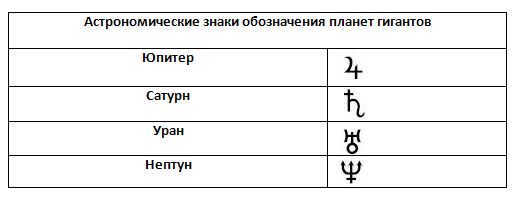
Common Features of the Giant Planets
- The outer planets, being the farthest from the Sun, have a lengthy solar orbit. For instance, Jupiter takes nearly 12 years, while Neptune takes over 164 years. The outer planets are consistently characterized by low temperatures.
- The giants are distinguished by their immense weight and size. Jupiter is 318 times heavier than Earth. Saturn is approximately 25% heavier than Jupiter, and Uranus and Neptune are only 5% heavier.
- These planets require a relatively short amount of time, around 10 to 17 hours, to complete a full rotation on their axis.
- Representatives of the outer system lack solid surfaces.
- The outer planets have a low density, which makes them relatively lightweight for their size.
- All gas giants have satellites and rings that orbit around them. The rings consist of thin disks made up of dust and rock, believed to have formed from shattered or unformed satellites.
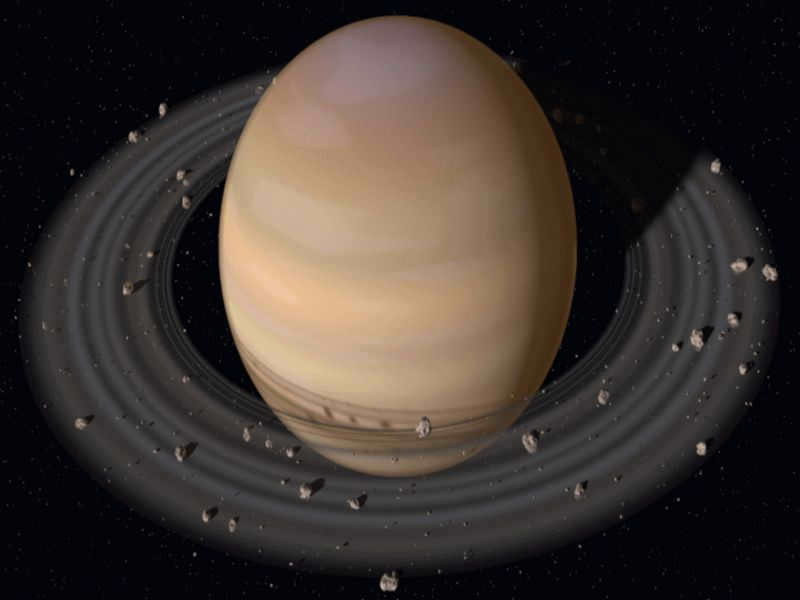
Estimating the masses of the colossal planets
Jupiter has a similar composition and internal structure to Saturn, although it is nearly four times more massive than the “failed star”. Uranus and Neptune, on the other hand, are much lighter compared to their larger counterparts.
Jupiter stands as a colossal entity among the giants. Its diameter is approximately 11 times that of Earth and roughly ten times that of the Sun. Its average density is 1.3 g/cm3, significantly lower than any of the planets in the Earth-group.
The mass of Saturn is 95 times greater than that of Earth. The giant’s average density is lower than that of water, measuring at only 0.7 g/cm3.
Uranus and Neptune, on the other hand, possess a mass 15 times that of Earth, making them just slightly more massive than Jupiter. Their densities are 1.3 g/cm3 and 1.6 g/cm3, respectively, which are much higher than Saturn’s density. As a result, it is not surprising that Uranus and Neptune differ significantly in terms of composition and structure from the initial gas giants.

The composition of the atmospheres of the giant planets
The chemical makeup of the atmospheres of the giant planets, namely Jupiter and Saturn, closely resembles that of the Sun. These massive celestial bodies are predominantly composed of two elements, hydrogen and helium, with hydrogen accounting for approximately 75% of their total mass and helium making up the remaining 25%. Unlike on Earth, where hydrogen and helium exist as gases, on Jupiter and Saturn, they are found in a liquid state due to the immense size and gravitational forces of these planets. Consequently, these two planets are often referred to as gas giants. The primary constituent of both Jupiter and Saturn is liquefied hydrogen, which is why they are sometimes referred to as liquid planets. The gravitational pull of these giants causes heavier elements to sink towards their interior, whether the planet is in a liquid or gaseous state.
In contrast, Uranus and Neptune, although smaller in size compared to their counterparts, contain a solid core made up of rock, metal, and ice. The atmospheres of these planets are relatively smaller when compared to the size of their cores.
Hydrogen and its numerous compounds are the predominant elements in the outer planets.

Giant Planets’ Table

There are still numerous enigmas surrounding the “Ice giants,” but their size is gradually decreasing with each passing year.

